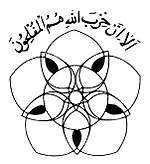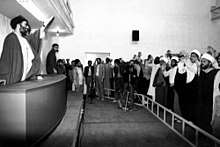Islamic Republican Party
The Islamic Republican Party (IRP; Persian: حزب جمهوری اسلامی, romanized: Ḥezb-e Jomhūrī-e Eslāmī, also translated Islamic Republic Party) formed in 1979 to assist the Iranian Revolution and Ayatollah Khomeini establish theocracy in Iran. It was disbanded in 1987 due to internal conflicts.
Islamic Republican Party | |
|---|---|
 | |
| Historical leader | Ruhollah Khomeini |
| Founders | List
|
| Founded | 17 February 1979[1] |
| Dissolved | 1 June 1987[1] |
| Headquarters | Tehran, Iran |
| Newspaper | Islamic Republican[2] |
| Paramilitary wing | Revolutionary Guards[3] |
| Worker wing | Workers' House |
| Membership (1979) | 2,500,000 claimed[4] |
| Ideology | Islamism[5] Khomeinism[6] Theocracy[2] Populism[2] Clericalism[2] Anti-imperialism[2] Anti-communism[2] Internal factions: Planned economy[7] Free market[7] Radicalism[1] Pragmatism[1] |
| Religion | Shia Islam |
| National affiliation | Islamic Coalition (1979) Grand Coalition (1980) |
| Slogan | One nation, one religion, one order, one leader[2] |
| |
Founders and characteristics
The party was formed just two weeks following the revolution upon the request of Ayatollah Khomeini.[8] Five cofounders of the party were Mohammad Javad Bahonar, Mohammad Beheshti, Akbar Hashemi Rafsanjani, Ali Khamenei, and Abdolkarim Mousavi-Ardabili.[8][9] Early members of the central committee of the party, in addition to founding members, were Hassan Ayat, Asadollah Badamchiyan, Abdullah Jasbi, Mir Hossein Mousavi, Habibollah Askar Oladi, Sayyed Mahmoud Kashani, Mahdi Araghi and Ali Derakhshan.[9] The party had three general secretaries: Beheshti, Bahonar and Khamenei.[9]
The party has been said to be distinguished by "its strong clerical component, its loyalty to Khomeini, its strong animosity to the liberal political movements, and its tendency to support the revolutionary organizations," such as the komiteh. Policies it supported included the state takeover of large capital enterprises, the establishment of an Islamic cultural and university system, and programs to assist the poor.[10]
These revolutionary ayatollahs originally used the party to form a monopoly over the post-revolutionary theocratic Iranian state. In its struggle with civilian opponents the party made use of its ties to the Revolutionary Guards and Hezbollah.
Secretaries-general
| Name | Tenure | Ref |
|---|---|---|
| Mohammad Beheshti | 1979–1981 | [9] |
| Mohammad Javad Bahonar | 1981 | [9] |
| Ali Khamenei | 1981–1987 | [9] |
Causes of its dissolution

In the late 1980s, factionalism in the IRP intensified, the major issues being the Iran-Iraq War, whether to open up to foreign countries or remain isolated, and economic policies. Because all rival parties had been banned, the party "did almost nothing and had little incentive to."[11]
According to Ahmad Mneisi,
"While unanimous on the idea of a theological state and united under the umbrella of one party, the Islamic Republican Party (IRP), [the religious right] differed on a number of issues, such as the extent to which religion is to take hold of political life (the Velayat-e Faqih debate).[12]
Daniel Brumberg argued that it was in response to the dispute between president Ali Khamenei and popular prime Minister Mir-Hossein Mousavi, that the IRP was dissolved - the Islamic Republican Party served "as a stronghold of radical activism," supporting Mousavi.[13] However, another report states that it was dissolved in May 1987 due to internal conflicts.[9][14] And the party was disbanded upon joint proposal of Rafsanjani and then party leader Khameini on 2 May 1987 when their proposal was endorsed by Ayatollah Khomeini.[8]
1983 congress
The party held its first congress in May 1983 and the members elected the 30-members central council as follows:[15]
|
|
Allied organizations
The following organizations formed an alliance with the party:[16]
Electoral history
Presidential elections
| Election | Main candidate | Votes | % | Result |
|---|---|---|---|---|
| 1980 | Hassan Habibi | 674,859 | 3.35 | 3rd |
| 1981, July | Mohammad-Ali Rajai | 12,779,050 | 87.69 | 1st |
| 1981, October | Ali Khamenei | 16,007,072 | 95.01 | 1st |
| 1985 | Ali Khamenei | 12,203,870 | 87.90 | 1st |
Parliamentary elections
| Election | Party leader | Seats | +/– | Position |
|---|---|---|---|---|
| 1980 | Mohammad Beheshti | 85 / 270 |
N/A | 1st |
| 1984 | Ali Khamenei | 130 / 270 |
1st | |
See also
References
- John H. Lorentz (2010). "Islamic Republican Party (IRP)". The A to Z of Iran. The A to Z Guide Series. 209. Scarecrow Press. pp. 143–144. ISBN 1461731917.
- Ervand Abrahamian (1989). Radical Islam: the Iranian Mojahedin. I.B.Tauris. pp. 42–45. ISBN 9781850430773.
- Said Amir Arjomand (1988). The Turban for the Crown: The Islamic Revolution in Iran. Studies in Middle Eastern history. Oxford University Press. p. 136. ISBN 9780195042580.
- New Iran bursting with mass politics, Detroit Free Press, 20 June 1979, p. 28
- Ghorashi, Halleh (2002), Ways to survive, battles to win: Iranian women exiles in the Netherlands and United States, Nova Publishers, p. 63, ISBN 978-1-59033-552-9
- M Nasif Sharani (2013). Esposito, John L.; Shahin, Emad El-Din (eds.). The Oxford Handbook of Islam and Politics. Oxford University Press. p. 196. ISBN 9780195395891.
- Antoine, Olivier; Sfeir, Roy (2007), The Columbia World Dictionary of Islamism, Columbia University Press, p. 150
- Behrooz, Maziar (October 1994). "Factionalism in Iran under Khomeini". Middle Eastern Studies. 27 (4): 597–614. doi:10.1080/00263209108700879. JSTOR 4283464.
- Asayesh, Hossein; Adlina Ab. Halim; Jayum A. Jawan; Seyedeh Nosrat Shojaei (March 2011). "Political Party in Islamic Republic of Iran: A Review". Journal of Politics and Law. 4 (1). Retrieved 29 July 2013.
- Bakhash, Reign of the Ayatollahs, (1984), p. 67
- Keddie, Nikkie, Modern Iran, 2003, pp. 259-60
- Mneisi, Ahmad. 2004. The Power shift within Iran's right wing Ahram, 5 July 2004
- Brumberg, Daniel, Reinventing Khomeini : The Struggle for Reform in Iran, University of Chicago Press, 2001, p. 134
- Nikou, Semira N. "Timeline of Iran's Political Events". United States Institute of Peace. Retrieved 27 July 2013.
- Mohammadighalehtaki, Ariabarzan (2012). Organisational Change in Political Parties in Iran after the Islamic Revolution of 1979. With Special Reference to the Islamic Republic Party (IRP) and the Islamic Iran Participation Front Party (Mosharekat) (Ph.D. thesis). Durham University. p. 159–161.
- Mohammadighalehtaki, Ariabarzan (2012). Organisational Change in Political Parties in Iran after the Islamic Revolution of 1979. With Special Reference to the Islamic Republic Party (IRP) and the Islamic Iran Participation Front Party (Mosharekat) (Ph.D. thesis). Durham University. p. 165.
| Ruling party of Iran | ||
|---|---|---|
| Vacant Title last held by Resurgence Party |
Islamic Republican Party 1981–1987 |
Vacant |